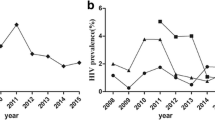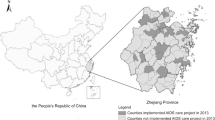Abstract
A survey of 87 Thai female commercial sex workers (TCSW) was conducted in Tokyo and surrounding areas to investigate their: 1) living conditions, 2) knowledge about HIV/AIDS and sources of information, and 3) working conditions and dealings with clients. Data were mainly collected by “snowballing” with semi-structured interviews. The results showed a majority of participants knew HIV could be contracted through sexual intercourse and that condom use could protect against HIV infection. However, some TCSW reported failing to use condoms despite having requested clients to do so. Reasons for client compliance with condom use were discussed. Although a majority of the participants underwent HIV testing at least once every 3 months, they did not learn much about HIV prevention through public information and education. The results suggest that workers and clients need more detailed information concerning HIV prevention as well as a greater accessibility.
Similar content being viewed by others
References
Oya A. Potential for spread of HIV in Japan. Japanese Journal of Public Health 1992;39(4):193–5.
Munakata T, Morita M. AIDS prevention from behavioral epidemiological point of view. Nichijou Shinryou To Ketueki. 1993;3(7):815–24.
Weniger BG, Limpakarnjanarat K, Ungchusak K. The epidemiology of HIV infection and AIDS in Thailand. AIDS. 1991;5 Suppl 12: 71–85
Rojanapithayakorn W. Current situation and strategies on HIV and AIDS in Thailand. Japanese Journal of Public Health. 1995;42(1):50–5.
Shiokawa Y. Epidemiology of AIDS in Japan. Nippon Rinshou. 1993:51:455–60.
Soda K, Ichikawa S. Potential for spread of HIV in Japan and in the world. Rinshoui. 1994;20(3):74–8.
AIDS Surveillance Committee, Ministry of Health and Welfare, Japan. 1998.
Ichikawa S, Kihara M, Sankary T, Imai K, Oya N, Kihara M. The survey of clients of foreign female sex workers in Japan. Annual report of the study group on HIV/AIDS epidemiology and intervention, The Ministry of Health and Welfare, Japan. 1996; 131–6.
Immigration Association. Annual Report on Immigration Administration. 1995.
Kihara M, Ichikawa S, Kihara M, Yamasaki S. Descriptive epidemiology of HIV/AIDS in Japan, 1985-1994. Journal of Acquired Immune Deficiency Syndromes and Human Retrovirology. 1997;14 Suppl 2:3–12.
Ngugi E, Plummer F. Prostitutes teaching prostitutes in Nairobi. AIDS prevention through health promotion: Facing sensitive issues. WHO. 1991;51–5.
Murray A, Robinson T. Minding your peers and queers: female sex workers in the AIDS discourse in Australia and South-East Asia. Gender, Place and Culture. 1996;3(1):43- 59.
Ohi G, Uemura I, Akabayashi A, Kai I, Miyasaka M, Naka K. Preventive behaviors against HIV transmission adopted by Japanese commercial sex workers (CSWs). Environmental Health and Preventive Medicine. 1997;3 October: 132–4.
Kihara M, Kihara M, Shimizu G, Soda K. STD and HIV infection among foreigner who visit the clinic in Ibaragi, Japan. Japanese Journal of Public Health. 1995;42(8):579- 85.
Nakanishi Y, Saito N, Morita R, Oyama Y, Jitthai N, Kihara M. HIV/AIDS counseling services for foreigners at the Shinjuku public health center. Japanese Journal of Public Health. 1997;44(5):391–9.
The Population Problems Research Council, The Mainichi Shimbun. Trend of contraceptive use. Toward a new century of Equality and symbiosis: Summary of twenty-third national survey on family planning. Tokyo. 1996; 177–99.
Coleman S. The cultural context of condom use in Japan. Studies in Family Planning. 1981;12(1):28–39.
Uchino H, Kihara M. Analysis of trends of STD/HIV transmission among the foreign female sex workers: the problem and current situations in Komoro city, Nagano prefecture. Japanese Journal of Publi Health 1995;42(9):807- 814.
Bangkok Times. 1997 June 25:6.
Bartholet J. Innocence for sale. Newsweek. 1996;December 23:15–8.
Jitthai N. Personal communication with the TCSW who reembarked to Japan.
Author information
Authors and Affiliations
Corresponding author
Rights and permissions
About this article
Cite this article
Jitthai, N., Miyasaka, M. HIV related knowledge and prevention among Thai female commercial sex workers in Japan. Environ Health Prev Med 3, 190–196 (1999). https://doi.org/10.1007/BF02932257
Received:
Accepted:
Issue Date:
DOI: https://doi.org/10.1007/BF02932257




